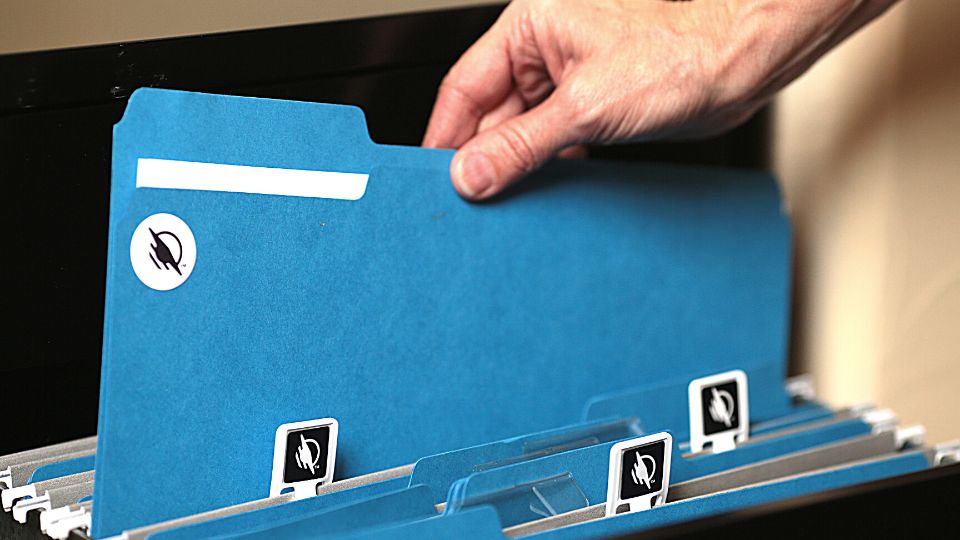Whether you work at home or in an office, maintaining an organized workspace will help increase your productivity and reduce stress. Good organization is especially important if you have poor eyesight. These office organization ideas cover three key areas: the main workspace, files and reference materials, and supplies. We’ll share ideas that work for anyone, and also some tips specifically for people with vision loss.
Office Organization Ideas for Your Main Workspace
The main workspace, or the desk, is where you’ll spend the majority of your working hours. Documents, supplies, and electronics can end up cluttering your desk, making it difficult to find what you need to complete a task. These tips will help you keep an organized and efficient workspace.
- Keep it tidy! Take a few minutes at the end of each day or work session to file papers and straighten up your desk. It’s an area that can easily snowball into a disaster zone. But it also doesn’t take long to keep it in ship-shape.
- Make sure everything has a place. Your best bet for a tidy desktop is to keep your files, papers, and supplies tucked away. We’ll cover ideas for organizing your files and paper documents in the next section.
- Think carefully about what you really need out on your desktop. Store items you use frequently in the most accessible locations, such as a desktop organizer or the top drawer of a desk. There are lots of great organizers for pens and highlighters, important files, and even docks that keep your devices charged.
- If you have limited vision, make good use of high contrast. For example, use black accessories on a light-colored desk.
- Get the lighting right. Adequate lighting is a must and oftentimes task lighting (a gooseneck lamp, for example) is important to successfully read printed materials. Combine an overhead fixture for general room lighting with a good desk lamp for task lighting. You can also use a ring light. They improve how you look on video calls and also add another light source to your workspace.
Organizing Files and Reference Materials
Mail, documents, and files can quickly take over if you don’t have a system to regularly process paper. There are lots of great resources for fine-tuning a system that works for you. These office organization tips for paper documents will help you get started.
- Go electronic whenever possible. Rather than keeping paper copies, scan documents and file them electronically. They will be easier to reference and more accessible to locate. You can often request electronic documents from banks, hospitals, utility companies and more–sometimes these companies even offer a small discount when you go paperless.
- Label everything! Start broad with items like shelves, drawers, and cabinets. Then further organize with hanging folders. Use large print labels like the kind you print out or use a sharpie to handwrite. Or you can use electronic labels like WayTags to label with more detail. WayTags work for doors, drawers, paper files, and more.
- Know where you keep important documents. You may want to keep legal documents in a fire safe. Use a WayTag on the back of documents like your Social Security card, birth certificates, marriage license, etc. If you don’t want to put the WayTag on the document itself, create a binder with plastic sleeves. You can put the WayTag on the sleeve to easily identify and access the document.
- Store like items together. APH Career Connect recommends using baskets and bins on shelves as well as in cabinets and closets.
- Keep your incoming mail sorted. Consider setting up files with labels like To File, To Read, or To Contact (write or call). Label each item with a discard date so you don’t add paper clutter.
Organization Ideas for Office Supplies
Don’t settle for cramming office supplies into a junk drawer. Keep your supplies organized and easy to find with these tips.
- A key organizing principle is to put like with like: pens, pencils, markers, and highlighters; sticky notes and notepads; stamps and envelopes. Think in terms of tasks that you do regularly and keep all of the supplies necessary to complete that task in the same location.
- Containerize! You can invest in customizable drawer dividers and desktop containers that will suit your style and the supplies you like to keep on hand. But containers don’t have to break the bank. Reuse metal coffee cans or soup cans and other containers to separate loose office supplies like paperclips and rubberbands.
- Keep spare charging cables together and label each one so you know which device it is compatible with.
- Label items you want to keep in stock, like extra printer toner. Use a WayTag to record the date you purchased the item and the link to reorder. When you use your last toner, click the link to reorder to make sure you have more the next time you need it.
- Use a combination of bump dots and WayTags to label controls, buttons, and switches that can be hard to tell apart.
What are your favorite office organization ideas? Tell us in the comments below!

